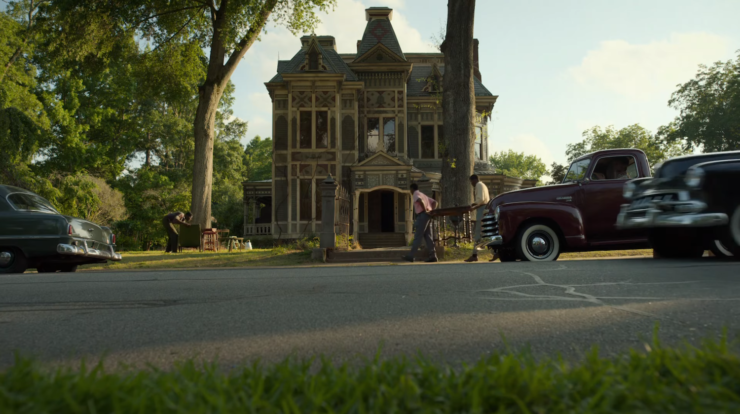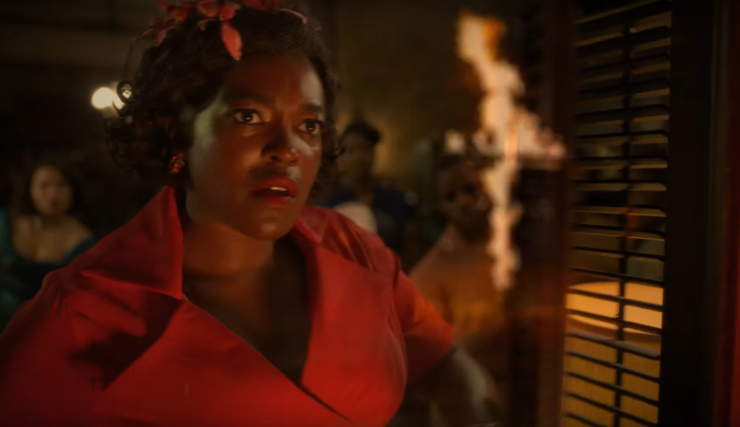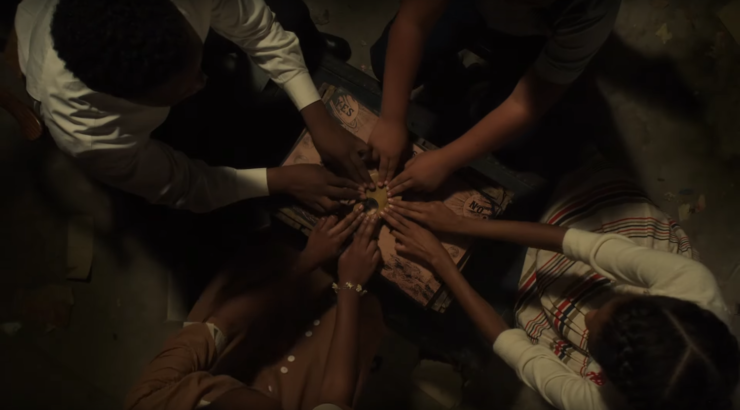Let’s dive into the third episode of Lovecraft County, where Leti buys a haunted house, Tic gets possessed, and Hippolyta has had it up to here with domineering men.
“Holy Ghost” keeps circling back to baseball. Montrose dreams of a moment during the Tulsa Massacre when he and George were rescued from a group of white men by a mysterious hero wielding a baseball bat who beat the men senseless “like Jackie Robinson.” When Montrose shows up at the Safe Negro Travel Agency looking all polished and clean (and temporarily sober), he says he wants to “hit a few balls with Dee,” using phrasing almost identical to Tic’s from earlier in the episode. Leti, swinging that baseball bat like she’s goddamn Beyoncé in direct contrast with those racist white boys looking to reenact the beating denied to their Tulsan compatriots. But I’m getting ahead of myself. Let’s start at the beginning.
One thing’s for sure, the opening scene of each episode holds all the clues for what is about to unfold while also standing on its own as a piece of sheer, brilliant art. For “Holy Ghost,” we begin in a Black church, with all the singing and dancing and gospel praising you can imagine. Leti sits there like she’s at a funeral—given what happened to Uncle George, she kind of is. She is a ghost in a church service. Everything washes over her and no one notices her.
And then you take in the narration from queer artist Precious Angel Ramirez. An ad from Nike is an unexpected thing to hear on a prestige cable TV show, but this one is special; it features legendary trans vogue dancer Leiomy Maldonado. Ramirez reminds us that women have always faced the impossible and come out the other side, but for Leti, flight is an act of fear, not bravery. She flies alright, away from her family troubles until she has no choice but to return, away from Tic and into the arms of other men, away from her feelings of insecurity and inadequacy and into a white neighborhood in a house she can barely afford. The house is supposed to be her escape, but it quickly becomes her cage.

The Winthrop House isn’t just in the North Side; despite being rundown, it’s by far the biggest and best house in the neighborhood. Bad enough that good, God-fearing white folks have to deal with a Black woman invading their neighborhood, but her doing it in a house that gives their houses all kinds of envy is a break to the social (i.e. white supremacist) hierarchy. It’s not all that different from Tic seating himself at the head of the white men’s table in the previous episode. The affront of it all.
We later learn she got the house with the help of a realtist. Historically, the difference between a realtist and realtor was that the latter was white and the former was Black. The National Association of Real Estate Brokers, an organization for Black real estate professionals founded in 1947, created the term for their members. Although many people use the terms “realtor” and “real estate agent” to mean the same thing, technically a realtor is a member of the National Association of Realtors, which was founded in 1908. Take a guess as to whether NAR let in Black agents in the 1950s.
Two quick tangents. Why yes, Martin’s birth name was Michael King. In the early 1930s, his father visited Germany and was deeply inspired by Martin Luther. He began going by M.L., and the name was passed down to his young son. And yes, MLK did have a white girlfriend, Betty Moitz. They dated while he attended divinity school in Pennsylvania. Neither are quite the controversies or scandals the partygoer makes them out to be, but they are parts of King’s biography that are often left out because they don’t fit the sanitized, neatly packaged version the white majority likes to tell.
Buy the Book


Ring Shout
Second, in Greek mythology, Hippolyta was the queen of the Amazons and the daughter of the first queen of the Amazons, Otrera, and Ares, the god of war. Diana was the Roman equivalent of the Greek goddess Artemis; She was the daughter of Jupiter (Zeus) and Latona (Leto, a Titan) and the twin sister of Apollo. Orithyia—as in Orithyia Blue from Dee’s handmade comic book—was another Greek queen of the Amazons and may have been Hippolyta’s sister. In DC comics, Hippolyta is the mother of Diana (aka Wonder Woman). She first appeared in 1941 as Hippolyte.
OK, back to the plot. Leti goes into the basement to fix the busted boiler that’s pumping hot air into the house. That’s when she discovers the haunted sub basement. She thinks something is trying to get out but what if it’s trying to get her to come in? At the party, a spirit threatens Dee and her friends while they play with a Ouija board. Something else lures Hippolyta to a darkened room. Leti and Tic finally give into their attraction and hook up rough and reckless in the bathroom. He doesn’t realize that was her first time. All this time she’s played the part of the seductive charmer because a boy once pinned that label to her like a red letter and now it’s almost impossible to remove.
The party ends in flames, but not fear. While a cross burns on her lawn and a gospel choir backs her up, Leti smashes up the cars of the racist white neighbors. When the cops show up, it’s no surprise they’re the ones arrested or that the white cops are racist assholes. But it is unexpected that Captain Lancaster is so interested in the Winthrop house. Turns out Winthrop was “experimenting” on Black people (on behalf of or with the support of the Sons of Adam) and burying their bodies in the sub basement. When Winthrop’s ghost orders her out of his house, she is driven by the same need for answers that pushed Montrose to dig up Dora’s history—and that need could lead to even more death if she can’t outsmart Winthrop.
This episode is really two ghost stories in one. Hiram Epstein haunts Leti and the Black ghosts haunt Hiram and the white boys. When the Black ghosts go after Leti, they are warning her, not trying to hurt her. What Hiram did to them was horrific, but not uncommon. White medical professionals have been “experimenting” on Black people since the dawn of chattel slavery. Enslaved Africans were cut open, peeled apart, and chopped up, usually without anesthesia because white people insisted Black people couldn’t feel as much pain (a theory that is still believed to this day by many medical professionals). The cruelty of James Marion Sims, celebrated as the “father of gynecology,” is one of the most well-known violators of Black bodies, but he was one of many.
To deal with this racist scientist, Tic and Leti bring in a Black exorcist. At the same time, three white boys break into the house to cause mayhem. With all that power swirling around, it’s a bad time to be an interloper. Once the Black ghosts are done with the white boys, they turn their attention to Hiram’s spirit. With Leti guiding them, they rise up against their abuser. Once again she is flying, this time not away but toward the thing she fears. She fights back, a hawk instead of a dove. She and the Black spirits feed on each other, giving each other the strength and power to send Hiram to hell.
Another strong episode. I really like that Misha Green retained the anthology structure from Matt Ruff’s novel, with each story playing with a different subgenre. Episode 3 feels like a haunted house story, not only because of the severed hands yanking the bed sheets off or the dead woman with half her face torn open or the clanging boiler or the elevator with a mind of its own. Yet, this episode is also where the show really breaks away from the book’s plot. The Winthrop story here is drastically different and much darker than in the book; the alterations imply major changes to the series ending as well. I’m on board for wherever Misha Green and Jordan Peele are headed.

Cultural texts referenced:
- Dracula and The Count of Monte Cristo get callbacks.
- The incident Ruby refers to is the Trumbull Park Homes Race Riots of 1953-1954. It all began when the Chicago Housing Authority assumed Betty Howard, a light-skinned Black woman, was white and “accidentally” integrated a housing project in the South Deering neighborhood. White folks weren’t having it. The CHA then moved in ten more Black families and even more violence broke out. White violence continued into the 1906s and prevented further integration. Today, the area is majority Black.
- The dog’s name is Baldwin and his owner is James. I see you Misha Green.
Final thoughts
- A MAN GHOST. WITH THE HEAD. OF A BABY.
- The white men leaving the car horns blaring for days on end is a prime example of how white supremacy will cut off its nose to spite its face. The horns aren’t just tormenting Leti’s boarders but the white neighbors, too.
- Who the hell leaves a bear trap in the middle of the floor?
- Leti being a virgin makes the hallucination Braithwaite cast on her in the second episode even more cruel.
- “Monsters. Spells. And Uncle George’s death.” “And I died, too. And honestly, since I’ve been back I feel like a ghost. Like something’s missing.”
- Uh, that’s a lot of bodies in that mysterious tunnel underneath the Winthrop house…
- “And Tic, really, you have to be smarter than this. You know you can’t just go around killing white women.” I hollered.
- Christina gave Tic an awful lot of information about spellwork and Horatio Winthrop’s missing pages without much prodding. He’d be wise to proceed with caution.
Alex Brown is a teen services librarian by day, local historian by night, author and writer by passion, and an ace/aro Black woman all the time. Keep up with her on Twitter and Insta, or follow along with her reading adventures on her blog.










